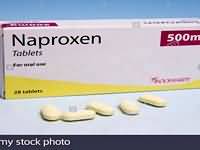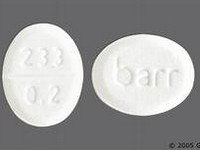naproxen

CLINICAL USE
NSAID and analgesic
DOSE IN NORMAL RENAL FUNCTION
Rheumatic disease: 0.5–1 g in 1–2 divided dosesMusculoskeletal disorders and dysmenorrhoea: 250 mg every 6–8 hours; maximum 1.25 g dailyGout: 250 mg every 8 hours
PHARMACOKINETICS
Molecular weight :230.3 %Protein binding :99 %Excreted unchanged in urine : <1 Volume of distribution (L/kg) :0.16half-life – normal/ESRD (hrs) :12–15/Unchanged DOSE IN RENAL IMPAIRMENT
GFR (mL/MIN)
20 to 50 : Dose as in normal renal function, but avoid if possible 10 to 20 : Dose as in normal renal function, but avoid if possible <10 : Dose as in normal renal function, but only use if on dialysis DOSE IN PATIENTS UNDERGOING RENAL REPLACEMENT THERAPIES
CAPD :Slightly dialysed. Dose as in GFR <10 mL/min HD :Not dialysed. Dose as in GFR <10 mL/min HDF/high flux :Unknown dialysability. Dose as in GFR <10 mL/minCAV/VVHD :Slightly dialysed. Dose as in GFR 10 to 20 mL/min IMPORTANT DRUG INTERACTIONS
Potentially hazardous interactions with other drugsACE inhibitors and angiotensin-II antagonists: antagonism of hypotensive effect; increased risk of nephrotoxicity and hyperkalaemiaAnalgesics: avoid concomitant use of 2 or more NSAIDs, including aspirin (increased side effects); avoid with ketorolac (increased risk of side effects and haemorrhage)Antibacterials: possibly increased risk of convulsions with quinolonesAnticoagulants: effects of coumarins enhanced; possibly increased risk of bleeding with heparins and coumarinsAntidepressants: increased risk of bleeding with SSRIs and venlafaxineAntidiabetic agents: effects of sulphonylureas enhancedAnti-epileptics: possibly increased phenytoin concentrationAntivirals: increased risk of haematological toxicity with zidovudine; concentration possibly increased by ritonavirCiclosporin: may potentiate nephrotoxicity Cytotoxic agents: reduced excretion of methotrexate; increased risk of bleeding with erlotinib Diuretics: increased risk of nephrotoxicity; antagonism of diuretic effect; hyperkalaemia with potassium-sparing diuretics Lithium: excretion decreased Pentoxifylline: increased risk of bleeding Probenecid: excretion reduced by probenecid Tacrolimus: increased risk of nephrotoxicity ADMINISTRATION
Reconstition
– Route
Oral Rate of Administration
–Comments
See how to identify renal failure stages according to GFR calculation
See how to diagnose irreversible renal disease
Home









